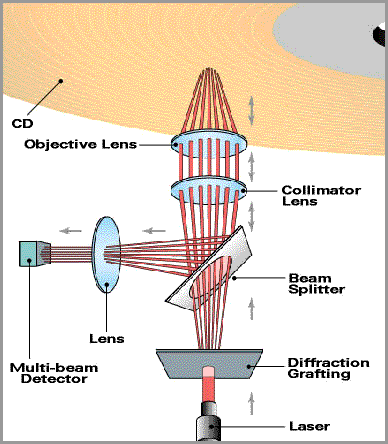Instead of just doing what everyone else had been doing for the past few years, Zen decided to take a totally different approach. Instead of just spinning the disc faster, they decided to use a totally revolutionary method that features multiple beams to read parallel tracks on the CD-ROM. Zen describes it best in their white paper as follows:
The Multiple Beam approach to illuminating and detecting multiple tracks uses a diffracted laser beam in conjunction with a multiple beam detector array. A conventional laser diode is sent through a diffraction grating which splits the beam into seven discrete beams, spaced evenly to illuminate seven tracks. The seven beams pass through a beam splitting mirror to the objective lens and onto the surface of the disc. Focus and tracking are accomplished with the central beam. Three beams on either side of the center are readable by a detector array as long as the center is on track and in focus.
The reflected beams return via the same path and are directed to the multiple beam detector array by the beam splitter mirror. The detector contains seven discrete detectors spaced to align with seven reflected tracks. Conventional detectors are also provided for focus and tracking.
With this technology, high performance CD-ROM drives can be made without such ridiculously high rotational speeds and without the use of CAV. The return to CLV has allowed for the replacement of the "max" part of the drive rating with the "TrueX" moniker.
Zen manufactures a component set consisting of optics and high speed ASICs. So far, only Kenwood Technologies who manufactures the 52X TrueX drive (as well as a 40X model), have picked it up. You'll also see these drives repackaged by Hi-Val and, more recently, they are included in some Compaq retail PC's.











4 Comments
View All Comments
dejaolsone1 - Monday, July 27, 2020 - link
Don't keep quiet and go boy, love is not like a game. https://theimpossible-quizbest.comPerty DJS - Friday, September 18, 2020 - link
https://www.perthmobiledjs.com.auhttps://www.allperthconcrete.com.au
https://www.joondaluprenovations.com.au
willammark - Thursday, March 25, 2021 - link
This post quite an informative post. I got some new information. I appreciate this post.https://www.ukessaywriters.co.uk/
denizwilliam - Friday, March 26, 2021 - link
There is one of the informative articles. I have one more site to get meaningful information link is below mention https://www.britishassignmentwriting.co.uk